Do Nails Have Blood Supply
| Nail | |
|---|---|
 | |
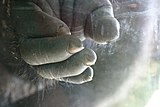 A gorilla's fingernails | |
| Details | |
| System | Integumentary system |
| Identifiers | |
| Latin | unguis |
| MeSH | D009262 |
| TA98 | A16.0.01.001 |
| TA2 | 7065 |
| Th | H3.12.00.3.02001 |
| FMA | 54326 |
| Anatomical terminology [edit on Wikidata] | |
A nail is a hook-like plate at the tip of the fingers and toes in most primates. Nails correspond to claws institute in other animals. Fingernails and toenails are made of a tough protective protein chosen alpha-keratin, which is a polymer. Alpha-keratin is found in the hooves, claws and horns of vertebrates.[ane]
Construction [edit]
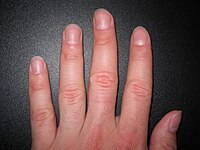
Fingernails

Toenails
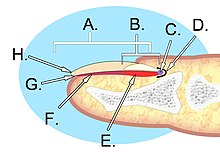
A. Nail plate; B. lunula; C. root; D. sinus; E. matrix; F. nail bed; K. hyponychium; H. free margin.
The nail consists of the nail plate, the smash matrix and the nail bed beneath it, and the grooves surrounding it.[2]
Parts of the nail [edit]
The matrix, sometimes called[iii] the matrix unguis, keratogenous membrane, nail matrix, or onychostroma, is the agile tissue (or germinal matrix) that generates cells, which harden as they move outward from the nail root to the nail plate.[4] It is the role of the nail bed that is beneath the smash and contains nerves, lymph and blood vessels.[5] The matrix produces cells that get the blast plate. The width and thickness of the nail plate is determined past the size, length, and thickness of the matrix, while the shape of the fingertip bone determines if the nail plate is flat, arched, or hooked.[6] The matrix will keep to produce cells as long every bit it receives nutrition and remains in a healthy condition.[vii] As new nail plate cells are fabricated, they push button older nail plate cells forrard; and in this way older cells go compressed, flat, and translucent. This makes the capillaries in the boom bed below visible, resulting in a pink colour.[ citation needed ]
The lunula ("small moon") is the visible part of the matrix, the whitish crescent-shaped base of the visible boom.[ citation needed ] The lunula tin best be seen in the thumb and may not be visible in the pinkie. The lunula appears white due to a reflection of light at the point where the boom matrix and blast bed meet.
The nail bed is the skin beneath the boom plate.[ commendation needed ] It is the area of the smash on which the nail plate rests. Nerves and blood vessels found hither supply nourishment to the entire nail unit of measurement. Like all skin, it is made of two types of tissues: the dermis and the epidermis. The epidermis is attached to the dermis by tiny longitudinal "grooves" called matrix crests (cristae matricis unguis).[iv] In old age, the nail plate becomes thinner, and these grooves get more than visible.[ citation needed ] The nail bed is highly innervated, and removal of the nail plate is often excruciatingly painful as a result.
The blast sinus (sinus unguis) is where the nail root is;[4] i.due east. the base of operations of the nail underneath the skin. It originates from the actively growing tissue beneath, the matrix.[ citation needed ]
The nail plate (corpus unguis)[4] sometimes referred to as the nail body, is the visible hard nail area from the nail root to the free edge, made of translucent keratin protein. Several layers of expressionless, compacted cells cause the nail to be strong just flexible. Its (transverse) shape is adamant by the form of the underlying bone.[ citation needed ] In common usage, the word nail often refers to this part merely. The nail plate is strongly attached to the smash bed and does not incorporate whatsoever nerves or claret vessels.
The free margin (margo liber) or distal edge is the anterior margin of the nail plate corresponds to the annoying or cutting edge of the blast.[iv] The hyponychium (informally known as the "quick")[eight] is the epithelium located beneath the nail plate at the junction between the free edge and the peel of the fingertip. It forms a seal that protects the smash bed. The onychodermal band is the seal between the nail plate and the hyponychium. It is merely under the complimentary edge, in that portion of the smash where the nail bed ends and tin can be recognized in fair-skinned people by its glassy, greyish colour. It is not visible in some individuals while it is highly prominent on others.[ citation needed ]
Eponychium [edit]
Together, the eponychium and the cuticle form a protective seal. The cuticle is the semi-circular layer of most invisible dead skin cells that "ride out on" and cover the dorsum of the visible blast plate while the eponychium is the fold of pare cells that produces the cuticle. They are continuous, and some references view them as one entity; in this classification, the names eponychium, cuticle, and perionychium are synonymous.[9] It is the cuticle (nonliving role) that is removed during a manicure, but the eponychium (living part) should not be touched due to adventure of infection.[ citation needed ] The eponychium is a small band of living cells (epithelium) that extends from the posterior nail wall onto the base of the nail.[iv] The eponychium is the stop of the proximal fold that folds back upon itself to shed an epidermal layer of skin onto the newly formed blast plate.[ contradictory ] The perionyx is the projecting border of the eponychium covering the proximal strip of the lunula.[iv]
The nail wall (vallum unguis) is the cutaneous fold overlapping the sides and proximal terminate of the boom. The lateral margin (margo lateralis) lies beneath the smash wall on the sides of the nail, and the nail groove or fold (sulcus matricis unguis) are the cutaneous slits into which the lateral margins are embedded.[4]
Paronychium [edit]
The paronychium is the soft tissue border around the nail,[ten] and paronychia is an infection in this area. The paronychium is the pare that overlaps onto the sides of the smash plate, also known as the paronychial edge. The paronychium is the site of hangnails, ingrown nails, and paronychia, a skin infection.
Hyponychium [edit]
The hyponychium is the area of epithelium, particularly the thickened portion, underlying the free edge of the blast plate. It is sometimes called the "quick", as in the phrase "cutting to the quick".
Function [edit]
A healthy fingernail has the function of protecting the distal phalanx, the fingertip, and the surrounding soft tissues from injuries. It as well serves to enhance precise delicate movements of the distal digits through counter-pressure exerted on the pulp of the finger.[2] The nail then acts equally a counter-force when the cease of the finger touches an object, thereby enhancing the sensitivity of the fingertip,[eleven] although the nail itself has no nervus endings. Finally, the boom functions as a tool enabling a so-called "extended precision grip" (eastward.g., pulling out a splinter in one'due south finger), and certain cutting or scraping deportment.
Growth [edit]
The growing part of the nail is under the pare at the nail'south proximal end under the epidermis, which is the merely living part of a nail.
In mammals, the growth rate of nails is related to the length of the final phalanges (outermost finger bones). Thus, in humans, the boom of the index finger grows faster than that of the little finger; and fingernails grow up to four times faster than toenails.[12]
In humans, fingernails grow at an average charge per unit of approx. 3.5 mm (0.fourteen in) a month, whereas toenails abound about one-half equally quickly (approx. average 1.6 mm (0.063 in) a calendar month).[13] Fingernails crave three to six months to regrow completely, and toenails require twelve to xviii months. Actual growth charge per unit is dependent upon age, sex activity, flavour, exercise level, diet, and hereditary factors.[14] The longest female nails known ever to take existed measured a total of 8.65 m (28 ft 4.five in).[fifteen] Contrary to popular conventionalities, nails do not continue to grow after death; the skin dehydrates and tightens, making the nails (and hair) appear to abound.[16]
Permeability [edit]
The nail is often considered an impermeable barrier, but this is non truthful. In fact, it is much more permeable than the peel,[17] and the composition of the nail includes 7–12% water. This permeability has implications for penetration past harmful and medicinal substances; in particular cosmetics applied to the nails can pose a risk. H2o tin can penetrate the nail as can many other substances including paraquat, a fast acting herbicide that is harmful to humans, urea which is frequently an ingredient in creams and lotions meant for utilise on easily and fingers, and several fungicidal agents such every bit salicylic acrid, miconazole branded Monistat, natamycin; and sodium hypochlorite which is the active ingredient in mutual household bleach (just usually merely in ii–3% concentration).[17]
Clinical significance [edit]

Healthcare and pre-infirmary-care providers (EMTs or paramedics) often employ the fingernail beds equally a cursory indicator of distal tissue perfusion of individuals who may be dehydrated or in daze.[eighteen] However, this test is not considered reliable in adults.[xix] This is known as the CRT or flinch test. The fingernail bed is briefly depressed to turn the nail-bed white. When the force per unit area is released, the normal pinkish colour should exist restored inside a second or two. Delayed return to pink color can be an indicator of certain shock states such as hypovolemia.[twenty] [21]
Nail growth record can evidence the history of contempo health and physiological imbalances, and has been used as a diagnostic tool since ancient times.[22] Deep, horizontally transverse grooves known as "Beau's lines" may form across the nails (horizontal, not along the smash from cuticle to tip). These lines are normally a natural effect of crumbling, although they may result from affliction. Discoloration, thinning, thickening, brittleness, splitting, grooves, Mees' lines, small white spots, receded lunula, clubbing (convex), flatness, and spooning (concave) can signal illness in other areas of the body, nutrient deficiencies, drug reaction or poisoning, or simply local injury.
Nails can also go thickened (onychogryphosis), loosened (onycholysis), infected with fungus (onychomycosis), or degenerate (onychodystrophy). A common nail disorder is an ingrowing toenail (onychocryptosis).
Deoxyribonucleic acid profiling is a technique employed by forensic scientists on pilus, fingernails, toenails, etc.
Health and care [edit]

A gear up of professional nail care tools
The best style to care for nails is to trim them regularly. Filing is too recommended, every bit to go on nails from becoming too rough and to remove any pocket-sized bumps or ridges that may crusade the blast to get tangled up in materials such as fabric.[23]
Blueish or purple fingernail beds may be a symptom of peripheral cyanosis, which indicates oxygen deprivation.
Nails tin can dry, just like peel. They can also peel, break, and be infected. Toe infections, for example, can be caused or exacerbated past dirty socks, specific types of ambitious exercise (long-distance running), tight footwear, and walking unprotected in an unclean environment.[ citation needed ] Common organisms causing nail infections include yeasts and molds (particularly dermatophytes).[24]
Boom tools used past different people may transmit infections. Standard hygiene and sanitation procedures avert transmission. In some cases, gel and cream cuticle removers tin be used instead of cuticle scissors.
Boom disease can be very subtle and should be evaluated by a dermatologist with a focus in this detail area of medicine. Yet, most times it is a boom technician who will note a subtle change in nail disease.
Inherited accessory nail of the fifth toe occurs where the toenail of the smallest toe is separated, forming a smaller "sixth toenail" in the outer corner of the nail.[25] Similar any other nail, it can be cut using a nail clipper.
Effect of nutrition [edit]
Biotin-rich foods[26] and supplements may assist strengthen breakable fingernails. A few small studies support biotin supplement use to that result.[27] 1 study in 35 people with brittle fingernails found that ii.v mg of biotin per day for six weeks to vii months improved symptoms in 63% of participants.[28]
Vitamin A is an essential micro-nutrient for vision, reproduction, cell and tissue differentiation, and immune function. Vitamin D and calcium work together in cases of maintaining homeostasis, creating musculus wrinkle, manual of nerve pulses, claret clotting, and membrane construction. A lack of vitamin A, vitamin D, or calcium can cause dryness and brittleness.
Insufficient vitamin B12 tin lead to excessive dryness, darkened nails, and rounded or curved nail ends. Insufficient intake of both vitamin A and B results in fragile nails with horizontal and vertical ridges. Some over-the-counter vitamin supplements such as sure multivitamins and biotin may assistance in growth of strong nails, although this is quite subjective. Both vitamin B12 and folate play a role in red claret jail cell production and oxygen transportation to nail cells. Inadequacies can consequence in discoloration of your nails.[29]
Omega-three fatty acids[xxx] can aid lubricate and moisturize your nails, giving them a shiny advent. These fatty acids may as well reduce inflammation in your nail bed, which nourishes and promotes the health of cells that requite rise to your nail plate. A lack of omega-3 fatty acids could contribute to dry and brittle nails.[31] [32]
Protein is a edifice material for new nails; therefore, low dietary protein intake may cause anemia and the resultant reduced hemoglobin in the claret filling the capillaries of the nail bed reflects varying amounts of light incident on the boom matrix resulting in lighter shades of pink ultimately resulting in white nail beds when the hemoglobin is very low. When hemoglobin is close to 15 or sixteen grams, most of the spectrum of light is absorbed and only the pink color is reflected back and the nails look pinkish.
Essential fatty acids play a large role in good for you peel also as nails. Splitting and flaking of nails may be due to a lack of linoleic acid.
Fe-deficiency anemia[33] can lead to a pale color along with a thin, brittle, ridged texture. Iron deficiency in general may cause the nails to become flat or concave, rather than convex. As oxygen is needed for good for you nails, an iron deficiency or anemia can lead to vertical ridges in your nails or your nails may concave or "spoon".[34] RDAs for iron vary considerably depending on age and gender. The recommendation for men is 8 mg per day, while that of women aged nineteen–l is 18 mg per day. After women hit age 50 or go through menopause, their iron needs drop to 8 mg daily.[35] [36]
Social club and culture [edit]
Fashion [edit]
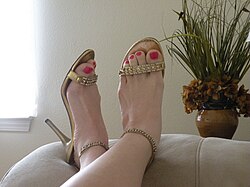
Manicures (for the easily) and pedicures (for the feet) are health and corrective procedures to groom, trim, and paint the nails and manage calluses. They crave various tools such every bit cuticle scissors, nail pair of scissors, blast clippers, and nail files. Bogus nails can also be fixed onto real nails for cosmetic purposes.
A person whose occupation is to cutting, shape and care for nails equally well as to use overlays such equally acrylic and UV gel is sometimes called a boom technician. The place where a boom technician works may be a nail salon or nail store or nail bar.
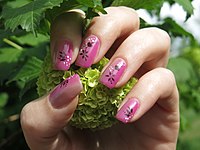
Acrylic nails are made out of acrylic glass (PMMA). When information technology is mixed with a liquid monomer (usually ethyl methacrylate mixed with some inhibitor) it forms a malleable dewdrop. This mixture begins to cure immediately, continuing until completely solid in minutes. Acrylic nails tin last up to 21 days but can last longer with bear upon-ups. To requite acrylic nails color, gel polish, nail smoothen, and dip powders tin can be applied.[37]
Painting the nails with colored nail shine (also called nail lacquer and nail varnish) to better the advent is a common practice dating dorsum to at least 3000 B.C. With the rise of smartphones, some analysts have noted a trend of the nelfie (nail selfie), wherein people share their blast art online.[38] Gel boom extensions and gel smash polish. Below are various manicure tools including a UV lamp for curing gel nails. Gel nails can be utilized in social club to create bogus boom extensions, simply can as well exist used similar nail polish. They are hardened using ultraviolet calorie-free. They last longer than regular blast polish and do not flake. They take a loftier-gloss terminate and final for 2 to three weeks.[39]
Blast wraps are formed by cut pieces of fiberglass,[40] [ circular reference ] linen, silk fabric, or another cloth to fit on the surface of the nail (or a tip attached prior), to be sealed onto the nail plate with a layer of resin or glue. They do not harm the smash and also provide strength to the nail but are non used to lengthen it. It can too be used to fix cleaved nails. The treatment is however more expensive.
With the dip pulverization method, a clear liquid is brushed onto a nail and the smash is then placed into pigmented powder.[41] Dip nails tend to last almost a calendar month, 2-3 weeks longer than gel and acrylic nails. Information technology can exist worn on natural nails, or with tips to create an bogus nail. Dip pulverization nails do not require any UV/LED lite to be cured, instead they are sealed using an activator.[ citation needed ] The quickest fashion to remove dip powder is to drill, prune off, or buff out layers of the powder then, when they are soaking in acetone, they slide correct off.[42] [43]
Length records [edit]
Guinness Globe Records began tracking record fingernail lengths in 1955, when a Chinese priest was listed equally having fingernails 1 pes 10.75 inches (57.79 cm) long.
The current record-holder for men, according to Guinness, is Shridhar Chillal from Bharat who prepare the record in 1998 with a total of 20 feet 2.25 inches (615.32 cm) of nails on his left hand. His longest boom, on his pollex, was 4 feet 9.6 inches (146.3 cm) long.
The record-holder for women is Lee Redmond of the U.Southward., who prepare the record in 2001 and as of 2008 had nails with a total length on both hands of 28 feet (850 cm), with the longest blast on her correct pollex at 2 feet 11 inches (89 cm).[44]
Development in primates [edit]
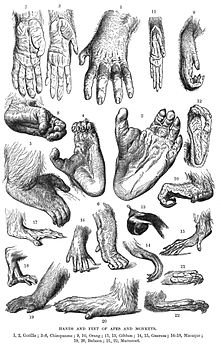
The boom is an unguis, significant a keratin structure at the finish of a digit. Other examples of ungues include the hook, hoof, and talon. The nails of primates and the hooves of running mammals evolved from the claws of earlier animals.[45]
In dissimilarity to nails, claws are typically curved ventrally (downwards in animals) and compressed sideways. They serve a multitude of functions—including climbing, digging, and fighting—and have undergone numerous adaptive changes in different animal taxa. Claws are pointed at their ends and are composed of two layers: a thick, deep layer and a superficial, hardened layer which serves a protective office. The underlying bone is a virtual mold of the overlying horny structure and therefore has the same shape as the claw or nail. Compared to claws, nails are apartment, less curved, and exercise not extend far beyond the tip of the digits. The ends of the nails ordinarily consist only of the "superficial", hardened layer and are not pointed similar claws.[45]
With but a few exceptions, primates retain plesiomorphic (original, "archaic") hands with v digits, each equipped with either a boom or a claw. For case, almost all living strepsirrhine primates have nails on all digits except the 2nd toe which is equipped with a preparation claw. Tarsiers accept a grooming claw on 2nd and third toes. Less usually known, a grooming claw is besides found on the 2d pedal digit of owl monkeys (Aotus), titis (Callicebus), and possibly other New Globe monkeys.[46] The needle-clawed bushbaby (Euoticus) has keeled nails (the thumb and the showtime and the 2d toes have claws) featuring a fundamental ridge that ends in a needle-like tip.
A study of the fingertip morphology of four small-bodied New World monkey species indicated a correlation between increasing small-branch foraging and:
- expanded apical pads (fingertips),
- developed epidermal ridges (fingerprints),
- broadened distal parts of distal phalanges (fingertip bones), and
- reduced flexor and extensor tubercles (attachments areas for finger muscles on bones).
This suggests that whereas claws are useful on large-diameter branches, broad fingertips with nails and epidermal ridges were required for habitual locomotion on modest-diameter branches. It besides indicates keel-shaped nails of Callitrichines (a family of New World monkeys) is a derived postural adaptation rather than retained ancestral condition.[47]
See also [edit]
- List of cutaneous conditions
- Blast disease
- Nail fetish
- Onychogryphosis, overgrown, claw-like nails
References [edit]
- ^ Wang, Bin (2016). "Keratin: Structure, mechanical properties, occurrence in biological organisms, and efforts at bioinspiration" (PDF). Progress in Materials Science. 76: 229–318. doi:10.1016/j.pmatsci.2015.06.001.
- ^ a b Onumah, Neh; Scher, Richard K (May 2009). "Nail Surgery". eMedicine. Retrieved x March 2010.
- ^ "Nail matrix". Biology Online. 2005. Retrieved x March 2010.
- ^ a b c d e f grand h Feneis, Heinz (2000). Pocket Atlas of Human being Anatomy (4th ed.). Thieme. pp. 392–95. ISBNthree-13-511204-7.
- ^ "Nail Matrix: Beefcake, Part, Injuries, and Disorders". Healthline. 2018-12-17. Retrieved 2021-09-01 .
- ^ "Nail Matrix: Anatomy, Office, Injuries, and Disorders". Healthline. 2018-12-17. Retrieved 2021-09-01 .
- ^ D. Schoon, Dougles (2005). Nail Structure and Products Chemistry. Milady. p. 6.
- ^ Crouch, James Ensign (1985). Functional man anatomy. Lea & Febiger. p. fourscore. ISBN9780812109306.
- ^ Elsevier, Dorland's Illustrated Medical Dictionary, Elsevier.
- ^ Jordan, Christopher; Mirzabeigi, Edwin (2000-04-01). Atlas of orthopaedic surgical exposures. Thieme. p. 101. ISBN0-86577-776-4.
- ^ Wang, Quincy C; Johnson, Brett A (May 2001). "Fingertip Injuries". American Family Doctor. 63 (10): 1961–6. PMID 11388710. Archived from the original on 13 October 2008. Retrieved 10 March 2010.
- ^ Cartmill, Matt; Lemelin, Pierre; Schmitt, Daniel (2007). "Primate Gaits and Primate Origins". In Ravosa, Matthew J.; Dagosto, Marian (eds.). Primate Origins: Adaptations and Development . pp. 403–35. doi:10.1007/978-0-387-33507-0_12. ISBN978-0-387-30335-2.
- ^ Yaemsiri, Southward.; Hou, North.; Slining, Thousand. Thou.; He, M. (2010). "Growth rate of human fingernails and toenails in healthy American young adults". Journal of the European Academy of Dermatology and Venereology. 24 (4): 420–423. doi:10.1111/j.1468-3083.2009.03426.x. ISSN 1468-3083. PMID 19744178. S2CID 856692.
- ^ Hunter, J. A. A., Savin, J., & Dahl, M. 5. (2002). Clinical dermatology. Malden, Mass: Blackwell Science. p. 173. ISBN 0-632-05916-eight
- ^ "A nail-biting encounter with the woman who has the longest fingernails". Guinness World Records. 2019-11-04. Retrieved 2020-11-07.
- ^ Vreeman, R. C; Carroll, A. Eastward (2007). "Medical myths". BMJ. 335 (7633): 1288–ix. doi:10.1136/bmj.39420.420370.25. PMC2151163. PMID 18156231.
- ^ a b K. A. Walters and M. Fifty. Flynn, Permeability characteristics of the human nail plate, International Journal of Cosmetic Science 5, 231–46 (1983)
- ^ Monterey County Ems Manual Archived 2008-12-16 at the Wayback Machine. Chapter Eleven, Patient cess.
- ^ Schriger DL, Baraff LJ (Jun 1991). "Capillary refill – is it a useful predictor of hypovolemic states?". Ann Emerg Med. xx (6): 601–fifteen. doi:ten.1016/S0196-0644(05)82375-3. PMID 2039096.
- ^ MedlinePlus Encyclopedia: Capillary nail refill test
- ^ St. Luke'southward Hospital. Capillary nail refill test.
- ^ American Academy of Dermatology – Blast Health
- ^ Cohen, Philip R.; Scher, Richard K. (1992-04-01). "Geriatric boom disorders: Diagnosis and treatment". Journal of the American Academy of Dermatology. 26 (4): 521–531. doi:10.1016/0190-9622(92)70075-Q. ISSN 0190-9622. PMID 1597537.
- ^ Denning, DW; Evans, EG; Kibbler, CC; Richardson, Physician; Roberts, MM; Rogers, TR; Warnock, DW; Warren, RE (November 11, 1995). "Fungal nail disease: a guide to proficient practice (study of a Working Grouping of the British Society for Medical Mycology)". British Medical Journal. 311 (7015): 1277–81. doi:10.1136/bmj.311.7015.1277. PMC2551187. PMID 7496239.
- ^ Haneke E (May 2016). "Double Smash of the Niggling Toe". Skin Appendage Disorders. 1 (4): 163–7. doi:10.1159/000443378. PMC4908446. PMID 27386457.
- ^ "B-Complex Vitamins: Benefits, Side Effects and Dosage". Healthline. 2018-06-07. Retrieved 2021-06-21 .
- ^ Floersheim, GL (1989). "Behandlung brüchiger Fingernägel mit Biotin" [Treatment of brittle fingernails with biotin]. Zeitschrift fur Hautkrankheiten (in German). 64 (1): 41–8. PMID 2648686. INIST:7283755.
- ^ Hochman, LG; Scher, RK; Meyerson, MS (Apr 1993). "Brittle nails: response to daily biotin supplementation". Cutis. 51 (four): 303–305. PMID 8477615. INIST:4679255.
- ^ Langan, Robert C.; Zawistoski, Kimberly J. (15 June 2011). "Update on Vitamin B12 Deficiency". American Family Dr.. 83 (12): 1425–1430. PMID 21671542.
- ^ "17 Science-Based Benefits of Omega-3 Fatty Acids". Healthline. 2018-x-xv. Retrieved 2021-06-21 .
- ^ Szyszkowska, Barbara; Łepecka-Klusek, Celina; Kozłowicz, Katarzyna; Jazienicka, Iwona; Krasowska, Dorota (June 2014). "The influence of selected ingredients of dietary supplements on skin condition". Advances in Dermatology and Allergology/Postȩpy Dermatologii i Alergologii. 31 (iii): 174–181. doi:10.5114/pdia.2014.40919. PMC4112259. PMID 25097490.
- ^ Zempleni, J; R.B. Rucker; D.B. McCormick; J.W. Suttie (2007). Handbook of vitamins (4th ed.). [ folio needed ]
- ^ "How to Increase the Absorption of Fe From Foods". Healthline. 2017-06-03. Retrieved 2021-06-21 .
- ^ Singal, Archana; Arora, Rahul (2015). "Nail equally a window of systemic diseases". Indian Dermatology Online Journal. half-dozen (ii): 67–74. doi:10.4103/2229-5178.153002. PMC4375768. PMID 25821724.
- ^ "- Dietary Reference Intakes for Calcium and Vitamin D - NCBI Bookshelf". 2011.
- ^ Cashman MW, Sloan SB (2010). "Nutrition and boom disease". Clinics in Dermatology. 28 (4): 420–25. doi:10.1016/j.clindermatol.2010.03.037. PMID 20620759.
- ^ "Hush-hush Ingredient: Acrylic Liquid".
- ^ Laneri, Raquel (eighteen Apr 2017). "Muslim women are showing off their insane smash art in 'nelfies'". NY Postal service . Retrieved 21 Feb 2019.
- ^ "Gel Manicures Look Skillful, just What's the Harm to Your Nails?". 12 Oct 2019.
- ^ "Fiberglass".
- ^ "Everything You Need to Know Nigh Dip Pulverisation Nails". 3 January 2017.
- ^ Simms, Janet (2003). A Practical Guide to Beauty Therapy for NVQ Level 2. ISBN9780748771509.
- ^ "How to Remove Dip Nails at Abode". 14 April 2020.
- ^ "Crash breaks woman'south tape-length fingernails". NBCNews. December 2009.
- ^ a b Ankel-Simons, Friderun (8 Jan 2007). Primate Anatomy: An introduction (3rd ed.). London, UK: Academic Press. pp. 342–344. ISBN978-0-12-372576-9.
- ^ Maiolino, South.; Boyer, D.Thou.; Rosenberger, A. (2011). "Morphological correlates of the grooming hook in distal phalanges of platyrrhines and other primates: A preliminary study". The Anatomical Record. 294 (12): 1975–1990. doi:x.1002/ar.21498. PMID 22042603. S2CID 3939930.
- ^ Hamrick, Mark W. (1998). "Functional and adaptive significance of primate pads and claws: Prove from New World anthropoids". American Periodical of Physical Anthropology. Wiley-Liss. 106 (2): 113–27. doi:10.1002/(SICI)1096-8644(199806)106:2<113::Assist-AJPA2>3.0.CO;2-R. PMID 9637179.
External links [edit]
-
 Media related to Nails at Wikimedia Commons
Media related to Nails at Wikimedia Commons
Source: https://en.wikipedia.org/wiki/Nail_%28anatomy%29
Posted by: carlinantiont.blogspot.com

0 Response to "Do Nails Have Blood Supply"
Post a Comment